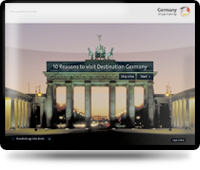Other highlights
Contact
kassel tourist GmbH
Obere Königsstrasse 15
34117 Kassel
Email:
tourist@kassel-tourist.de
Internet:
www.kassel-tourist.de
Obere Königsstrasse 15
34117 Kassel
Email:
tourist@kassel-tourist.de
Internet:
www.kassel-tourist.de
Museums

The Fridericianum was built in the contemporary neo-classical style by Simon Louis du Ry between 1769 and 1779, who drew inspiration from the British Museum in London. It was the first museum on the European mainland to open to the public, and its patron, Frederick II, is commemorated by a huge marble statue opposite the building. Since 1988, in the years when the documenta art exhibition is not being staged, the Fridericianum has hosted temporary art exhibitions. Its place in the art world is now firmly established, both as the principle location for documenta and also as a venue of special exhibitions.
» www.fridericianum-kassel.de
Jacob (1785-1863) and Wilhelm Grimm (1786-1859) are two of the leading intellectuals in German and European cultural history They shot to fame with their collection of fairy tales, but their pioneering work in the fields of Germanic language and literature, law, history and mythology as well as their political activity are also highly significant. The museum, which was established in 1959, is an institution with an international outlook. Its collections include documents that illustrate the life and works of the Brothers Grimm and their worldwide influence. The exhibition details the most important places where the Brothers Grimm lived and worked in chronological order and in relation to their scientific and political activities. The famous Grimms' fairy tales, which are firmly rooted in our culture, can be found in an appropriately themed room. Multilingual guided tours on request.
» www.grimm-museum.de
The Natural History Museum in the Ottoneum in Kassel has its roots in an art collection created in 1568 by Landgrave Wilhelm IV, which also contained a number of natural history items. Its permanent exhibition, including world-class botanical, geological, zoological and aquatic collections, introduces visitors to the shift in our understanding of nature. Major exhibits include the 400-year old "Ratzenberger Herbarium" – Europe's oldest systematic plant collection, Schildbach's Wood Library dating from the 18th century, and "Goethe's elephant", one of the first large skeletons of a mammal ever to be preserved. The section on the history of the Earth shows visitors how the environment around Kassel has changed over millions of years. Closed on Mondays – except on public holidays – and on 24 and 31 December. Guided tours available.
» www.naturkunde-museum.de
A variety of exquisite objets d'art from the collection of the department of arts, crafts and sculpture is displayed on the top floor of the Hessian State Museum. The exhibition spans the 8th century to the 19th century and is grouped into themes such as porcelain, glass and medieval sculpture. Visitors can see silver vessels, goblets, faience (Höchst, Flörsheim, Frankfurt and Kassel), porcelain (Meissen and Fulda), enamelled glassware and baroque glassware by various manufacturers, art and design and furniture. Closed on Mondays.
» www.museum-kassel.de
Hessen's State Art Collections, exhibited in a variety of museums in Kassel, illustrate a longstanding tradition and passion for collecting, preserving and arranging. The diversity of art treasures on display is great, representing the range of interests of the Landgraves and later the Electors of Hessen-Kassel who were collecting these significant art treasures more than 600 years ago. They include an antiquities collection, an old masters gallery, a collection of prints and drawings, prehistory and early history, an applied arts collection, cultural heritage, paintings and sculptures from 1750, an astronomy and physics exhibition, military and hunting history and a wallpaper museum. Guided tours on request.
» www.museum-kassel.de
The only one of its kind in Germany, covering an area of 1,400m², the museum was opened in 1992 and houses a wide range of sepulchral objects, both historical and modern: coffins, funeral carriages, mourning attire and jewellery, gravestones, sculptures and everyday objects associated with dying, death and commemoration. The exhibition also covers death and burial rites as well as the design of cemeteries, graves and monuments. In addition, the museum has a collection that currently consists of around 16,500 drawings and prints dating from the 15th century to the present day, as well a reference library with monographs, catalogues, special editions and a number of magazine articles on sepulchral culture. Closed on Mondays (except on public holidays), guided tours on request.
» www.sepulkralmuseum.de
The Museum of Astronomy and Technical History and the Planetarium have been housed in the Orangery since 1992. On display is a broad range of fascinating scientific and technological objects from the Renaissance period to the modern day. The entrance hall introduces the museum's main themes of basic physical concepts: space, time, matter, energy and information. Highlights of the collection include astronomical instruments invented by Ebert Baldewein and Jost Bürgi, as well as rare and exquisite telescopes and clocks for measuring time and space from the fields of physics, microscopy and optics. Celestial globes, armillary spheres and astrolabes from the 16th century, reconstructions, models and interactive experiments bring the enthralling exhibition to life. On the third floor of the central building, above the smaller photography and meteorology sections, lies the ten-metre dome with the Zeiss planetarium projector. Guided tours available. Closed on Mondays, 1 May, one day before Ascension Day, 24, 25 and 31 December.
» www.museum-kassel.de
Travel Planner
Select an option...




